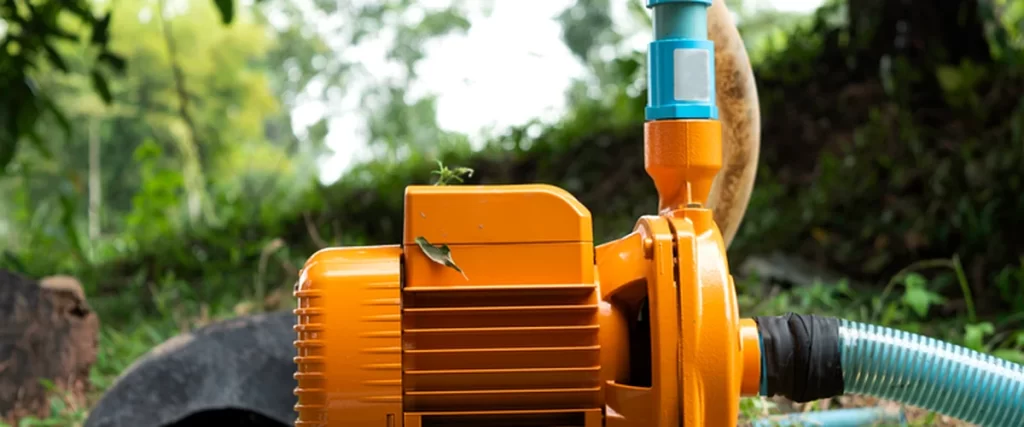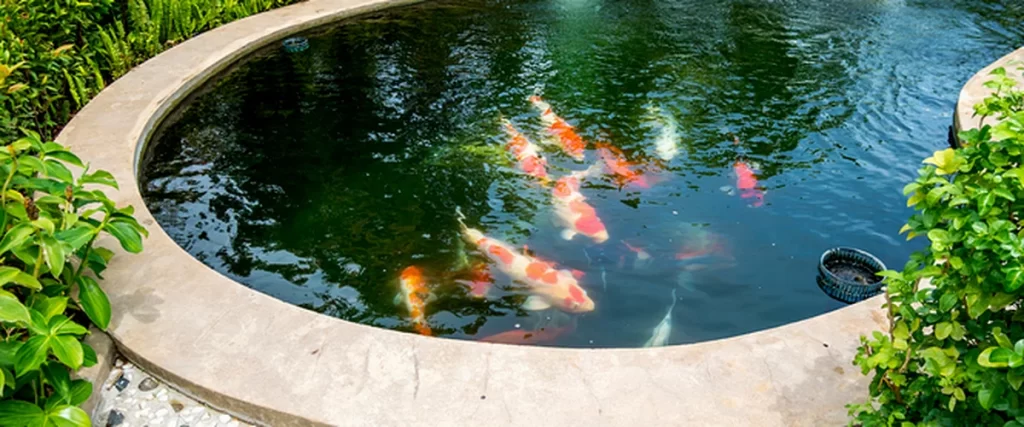A koi pond is a living ecosystem that depends on balance. Clear water, healthy koi fish, and thriving aquatic plants all rely on one invisible ingredient: oxygen.
Without proper oxygenation, even the most beautiful pond can struggle. That’s where a koi pond air pump becomes the heart of the system, quietly keeping everything alive and well.

The Role of Oxygen in a Koi Pond
Every living thing in your pond, from fish to beneficial bacteria, needs oxygen to survive. When oxygen levels drop, the water quality declines, and stress increases for the koi.
Koi fish consume oxygen as they breathe, but they aren’t the only ones competing for it. Microorganisms, plant roots, and even the natural process of breaking down organic matter all draw oxygen from the water.
During warm Florida summers, oxygen levels can drop quickly, especially in still ponds with limited water circulation.
Without aeration, a pond becomes stagnant. Algae blooms thrive, debris collects at the bottom, and oxygen-depleted water forms near the surface. Fish begin to gasp at the top, and the natural balance of the pond starts to fall apart.
A koi pond air pump prevents this by delivering a steady flow of air, keeping the entire system alive and in motion.
How an Air Pump Works
An air pump pushes air through tubing into the pond, where it exits through a diffuser or air stone. These devices create small bubbles that rise to the surface. As they move, they carry oxygen into the water while helping carbon dioxide and other gases escape.
This process, known as gas exchange, is what keeps water healthy and vibrant. The constant movement also helps distribute oxygen evenly throughout the pond, so no area becomes starved of air.
Different aeration systems use slightly different designs, but they all share a common goal: keeping oxygen levels steady. Some rely on diaphragm compressors, while others use piston or linear models. The choice depends on the pond’s depth, size, and how many koi it holds.
Benefits of Reliable Aeration
1. Healthier Koi Fish
Koi are hardy fish, but they need oxygen-rich water to thrive. When oxygen levels drop, they become sluggish and more vulnerable to disease. A constant supply of air ensures they stay active, colorful, and stress-free.
2. Stronger Beneficial Bacteria
The bacteria in your filtration system play a vital role in breaking down waste. These microorganisms require oxygen to process ammonia and nitrites, keeping the water safe. Without aeration, the bacteria slow down, and toxins begin to accumulate.
3. Better Water Clarity
Aeration keeps organic matter from settling on the bottom. It lifts debris and particles, allowing filters to catch them more effectively. This circulation helps maintain water clarity and reduces unpleasant odors.
4. Reduced Algae Growth
Algae blooms thrive in stagnant water. Aeration disrupts their growth by keeping nutrients and sunlight moving through the pond. The result is a cleaner, more balanced environment that naturally limits algae.
5. Support for Aquatic Plants
Aquatic plants benefit from steady oxygen levels too. Their roots absorb nutrients more efficiently when the surrounding water is oxygenated. They, in turn, help stabilize the pond’s ecosystem.

Why Aeration Matters in Warm Climates
Florida’s warm weather is beautiful, but it can be tough on koi ponds. Warmer water holds less oxygen, which makes aeration even more important. During the summer, when koi are most active and feeding more, their oxygen demand increases.
Without enough air, they struggle. A reliable koi pond air pump offsets this natural imbalance by constantly pumping air through the pond, keeping conditions stable throughout the year.
Even in winter, when the temperature drops, aeration helps. In colder regions, a pond may freeze at the surface. A pond air pump can keep a small hole in the ice, allowing gases to escape and preventing fish from suffocating beneath the surface.
Choosing the Right Air Pump
Not all air pumps are the same. The right model depends on your pond’s depth, shape, and size. When selecting one, consider these points:
- Pond size and depth: Deeper ponds need stronger pumps with higher pressure output to reach the bottom.
- Energy efficiency: Look for models with low energy consumption and high performance. An energy-efficient design can run continuously without raising electricity costs.
- Durability: Outdoor use requires robust, weather-resistant materials that can handle rain, heat, and humidity.
- Noise level: Modern pumps are engineered for quiet operation, so you can enjoy your pond without background humming.
- Diffuser quality: Fine-bubble diffusers spread oxygen more evenly and help improve water circulation.
A reliable aeration system is an investment. While price can vary by brand and capacity, it’s worth choosing a durable unit built for long-term performance.
Where to Place the Air Pump
The location of the air pump affects its efficiency. Most setups keep the compressor outside the pond, connected by tubing to diffusers placed underwater.
Some helpful placement tips:
- Keep the pump in a shaded area to avoid overheating.
- Elevate it slightly above pond level or install a check valve to prevent backflow.
- Position diffusers in deeper sections for even oxygenation.
- Avoid placing them directly under waterfalls or strong fountains to prevent turbulence overlap.
How Aeration Supports Filtration
Your filtration system relies on oxygen to function. The bacteria living in the filter convert harmful waste into less toxic compounds through an oxygen-dependent process. Without enough air, this cycle slows down, and waste begins to accumulate.
Aeration also prevents debris from settling at the bottom. The gentle movement keeps particles suspended long enough for the filters to remove them. Over time, this keeps the pond clean, reduces sludge buildup, and improves overall water quality.
When filters, aerators, and pumps work together, the pond maintains a healthy rhythm that supports both koi and plants.
Energy Efficiency and Modern Designs
Modern aeration systems are designed to be energy-efficient and long-lasting. Advances in materials and engineered components mean they deliver strong oxygenation with low energy consumption.
Many models now feature adjustable air output, allowing you to fine-tune aeration based on the pond’s size or season. This flexibility saves power during cooler months when koi are less active and require less oxygen.
Some systems also include multiple diffusers to spread air evenly through large or irregularly shaped ponds. This ensures consistent gas exchange across the entire surface.
Preventing Winter Problems
In colder months, aeration plays a critical role in keeping the pond stable. Without air movement, gases from decomposing material become trapped under ice, creating a toxic environment. A running air pump keeps a small area open, preventing freezing across the entire surface.
The bubbles also help circulate water near the top, allowing oxygen to continue reaching the fish below. Even if the koi become less active in winter, the pond still needs air circulation to remain balanced.
Maintaining Your Air Pump
A little maintenance helps the system stay effective and efficient.
- Check the tubing and diffuser for clogs or mineral buildup.
- Replace worn diaphragm parts if the pump begins losing pressure.
- Keep the compressor clean and protected from direct rain.
- Monitor airflow to ensure even distribution throughout the pond.
With simple care, a good koi pond air pump can last for years, providing steady aeration that keeps your fish and plants thriving.
A Balanced Ecosystem Starts with Air
A koi pond is a living network. Fish, plants, bacteria, and filters all depend on oxygen. The air pump acts as the link between them, ensuring each part functions properly. When the pond stays oxygenated, everything within it stays healthier, cleaner, and more vibrant.

Conclusion: Let Professionals Handle the Details
Installing and maintaining a koi pond air pump may seem simple, but getting the balance right takes experience. Depth, pump strength, diffuser placement, and pond size all matter. A professional can ensure your system runs smoothly, without wasted power or uneven oxygen distribution.
If you’d rather enjoy your koi pond than manage all the details of aeration and maintenance, our team at SitePro Landscaping can help. We design, install, and maintain pond aeration systems built for Florida’s unique climate.
For dependable pond maintenance that keeps your koi healthy year-round, call us at (407) 480-0713 or message us here.
